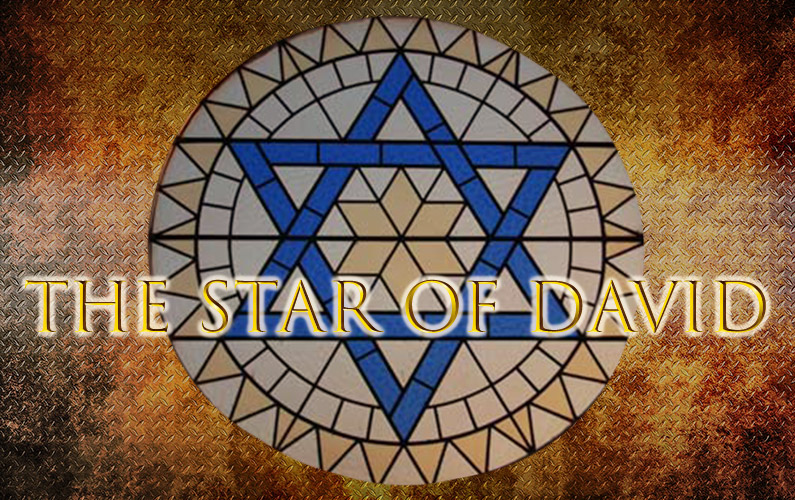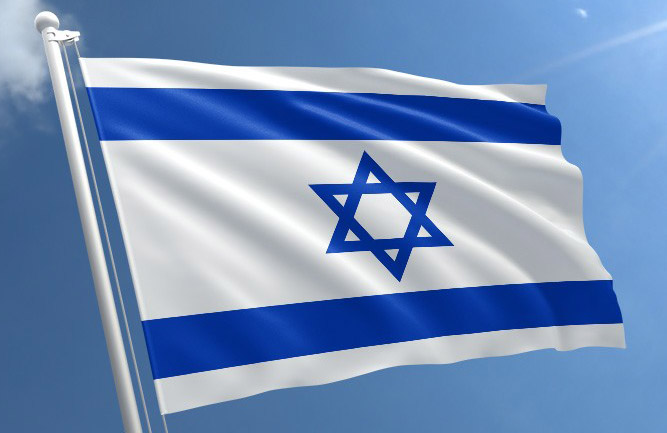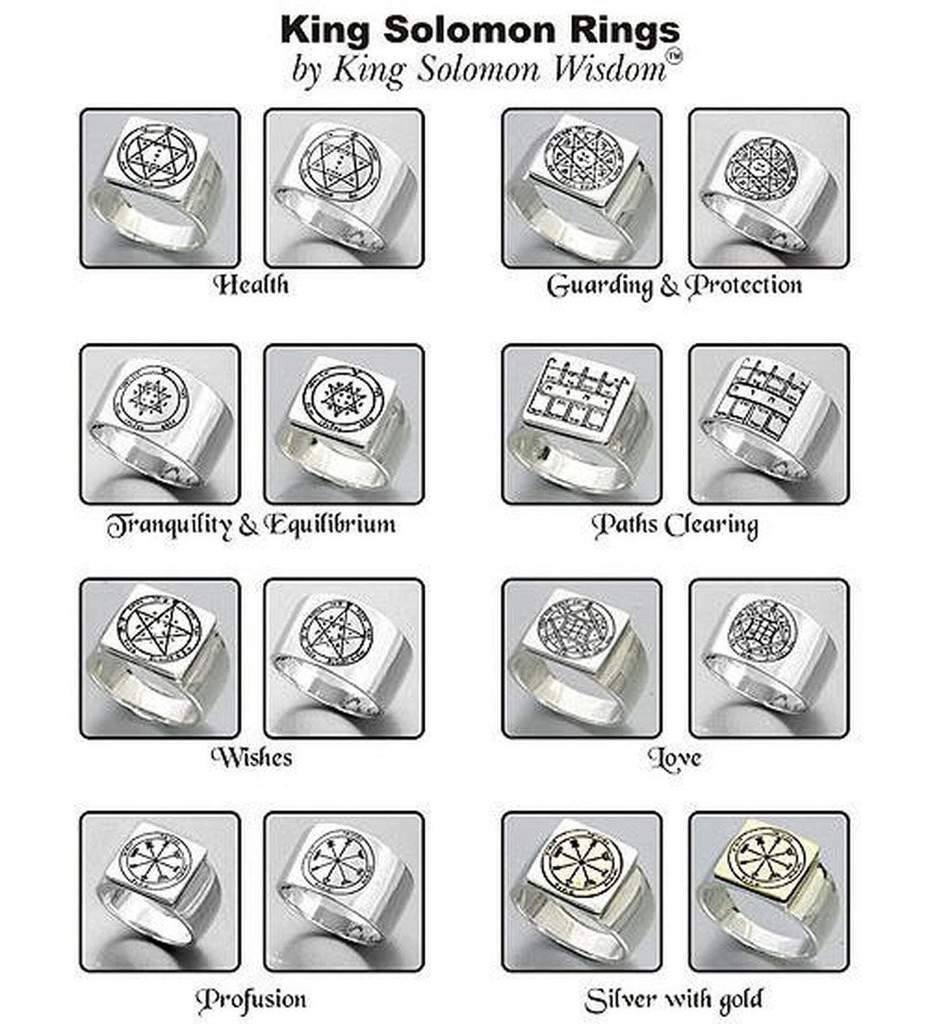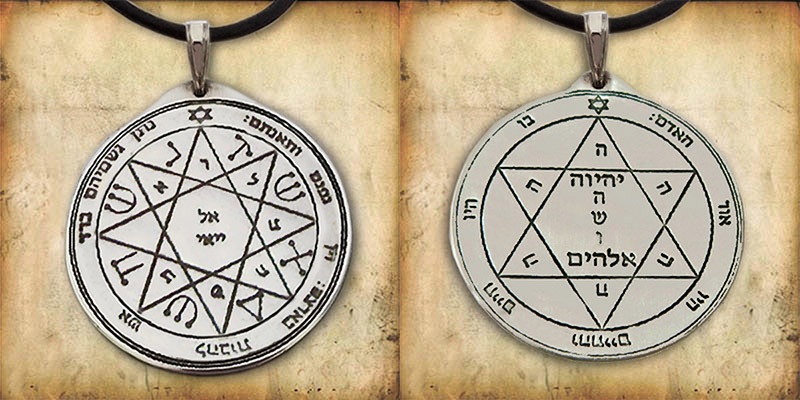
The Star of David
Why is it that some believers in the New Testament Messiah, Yahushua, embrace the Jewish emblem – the Star of David. Could it be because these believers are naively led to believe that this emblem is from Scripture somewhere and somehow has become lost to Christianity.
Do these believers feel that by embracing this emblem that they are drawing closer to their Biblical roots?
What is the origin of this emblem and what meaning does it hold for believers in Y’Shua?
After reading the following and watching the video footage – You decide.
The Israel Flag and the Emblem
The Star of David
The following information was taken off the Israel Ministry of Foreign Affairs website – link below:
Unlike the menora (candelabrum), the Lion of Judah, the shofar (ram’s horn) and the lulav (palm frond), the Star of David was never a uniquely Jewish symbol. The standard name for the geometric shape is a hexagram or six-pointed star, composed of two interlocking equilateral triangles. In a classic article, Gershom Sholem shed light on the history of the “Star of David” and its connection with Judaism and tried to answer the question whether it was appropriate to include it in the national flag or state emblem.*
One of the first Jewish uses of the Star of David was as part of a colophon, the special emblem printed on the title page of a book. Sometimes the printer included his family name in the colophon; or chose an illustration that alluded to his name, ancestry, or the local prince, or a symbol of success and blessing. The idea was to differentiate this printer’s books from those of his competitors and to embellish the title page. Colophons are as old as the printing press itself.
According to Sholem, the motive for the widespread use of the Star of David was a wish to imitate Christianity. During the Emancipation, Jews needed a symbol of Judaism parallel to the cross, the universal symbol of Christianity. In particular, they wanted something to adorn the walls of the modern Jewish house of worship that would be symbolic like the cross. This is why the Star of David became prominent in the nineteenth century and why it was later used on ritual objects and in synagogues and eventually reached Poland and Russia. The pursuit of imitation, in Sholem’s opinion, led to the dissemination of an emblem that was not really Jewish and conveyed no Jewish message. In his opinion, it was also the reason why the Star of David satisfied Zionism: it was a symbol which had already attained wide circulation among the Jewish communities but at the same time evoked no clear-cut religious associations. The Star of David became the emblem of Zionist Jews everywhere. Non-Jews regarded it as representing not only the Zionist current in Judaism, but Jewry as a whole.
* G. Sholem, “The Curious History of the Six Pointed Star; How the ‘Magen David’ Became the Jewish Symbol,” Commentary, 8 (1949) pp. 243-351.
The Star of David is an outstanding example of the variable significance of symbols. The power of the message they convey stems less from the original use in history. At first the Star of David had no religious, political, or social connotations whatsoever. It gained a very powerful connotation precisely as a result of its terrible abuse by the Nazis.
The blue and white stripes which symbolize a life of purity, guided by the precepts of the Torah, and the Star of David, which symbolizes rebirth and new life for the Jewish people, tie the State of Israel, through its flag, to the past, present and future. This is evidently why the Zionist flag prevailed over the political considerations that had prompted the leaders of the new state to propose substitutes for it.
source – https://www.mfa.gov.il/mfa/aboutisrael/israelat50/pages/the%20flag%20and%20the%20emblem.aspx

King Solomon’s Seal
What is the relationship or connection between the Star of David and King Solomon’s Seal?
Does this relationship outline the origin of the Star of David that is used as the emblem for Israel?
The following information was also found on the Israel Ministry of Foreign Affairs website – link below:
‘Set me as a seal upon thy heart’
(The Song of Songs which is Solomon’s, 8:6)
King Solomon, the son of King David, established Jerusalem as the city of justice and peace. His name reflects the original name of the city, Shalem. Solomon is said to have been given both “wisdom and knowledge”, this is usually taken to mean wise government, the ability to distinguish morally between good and evil, and a thorough understanding of the universe. “Behold I have given you a wise and understanding heart; there has been none like you before you, nor after you shall any arise like you” (Kings 1, 3, 12).
The legend of King Solomon’s Seal, of the wondrous signet ring which he received from heaven, is common to Judaism, to Christianity and to Islam. King Solomon’s Seal, whose base is on the ground and whose tip reaches heaven, symbolizes a harmony of opposites, whose significance is manifold as much as it is multi-cultural. It reflects the cosmic order, the skies, the movement of the stars in their spheres, and the perpetual flow between heaven and earth, between the elements of air and fire. The Seal, therefore, symbolizes super-human wisdom and rule by divine grace.
In 1536 ce, Sultan Suleiman the Magnificent ordered extensive restorations on the Temple Mount and converted the church which had been built on Mount Zion during the Crusader conquest into a mosque. By building this mosque, Suleiman linked himself both to Solomon the son of David and the Davidic Messiah who, according to Christian belief, is Jesus. It was Sultan Suleiman’s messianic consciousness which led him to develop the link between himself and King Solomon. On the walls which be built around Jerusalem are stone decorations in the form of two interlocking triangles Stars of David, known to Moslems as Khatam Suleiman and to Jews as Khatam Shlomo (King Solomon’s Seal) whose function was to protect the city. The symbol of the hexagram, the star-like figure formed by two triangles, has many connotations, especially when it is enclosed by a circle; super-natural powers have been attributed to it in many parts of the world since ancient times. Beyond the Jewish national associations which have only become attached to it in the last few hundred years, the abstract element of the figure (which is connected to the celestial stars) and its geometrical completeness make it a universal symbol. Together with the five-pointed star (the pentagram, which is of much earlier origin) the hexagram represents the development of mathematics and geometry by the Greeks and their successors around the Mediterranean.
Through geometry, in which the Pythagoreans and their followers saw cosmic symbolism, the hexagram and the pentagram became an expression of heaven and its reflection on earth, the divine and its reflection in creation and of the connection between heaven and earth, between the macrocosm and the microcosm, and between spirit and matter.
Islamic civilization was a vibrant crossroads of culture through which the achievements of the ancient world flowed into modern-day Europe, through which information passed from east to west and back again, and in which various ethnic groups of different languages and religions lived side by side and contributed to cultural advancement.
King Solomon’s Seal combines strength and beauty, symbolism and illustrative quality and all within a geometric figure, the most important characteristic of Islamic art. The Moslem artist’s love of geometry allows the true essence of King Solomon’s Seal as a symbol of the connection between the two worlds to be expressed; in this context, it symbolizes the link between science, beauty and metaphysics, with elements of medicine and magic, astronomy and astrology, the art of irrigation and its influence on the garden, and the symbolic connection between pleasure gardens and the Garden of Eden, between the sky and architectural domes and on traditional cosmology and its connection to religion.
Today, the hexagram is known as the “Star of David” and is seen as the definitive symbol of Judaism the term is even used in Islamic countries. There is a degree of confusion about its origins, name and associations. In Europe, the pentagram is usually known as King Solomon’s Seal, while the hexagram is known as the Star of David; and it is often assumed that this was always the case. However, the evidence points to the gradual evolution of the hexagram from a Roman cosmological symbol to a religious and magical symbol which was not specifically connected to one religion or people. Research suggests that both motifs were used by different religions and that the clearest meaning of the hexagram is associated with magical techniques to ward off evil forces. Professor Gershom Scholem, the noted scholar of the Kabbalah (Jewish mystic writings) studied the protective function of the hexagram and its entry into Judaism from Islamic traditions. In a series of articles on the Star of David and its history, Scholem made the following claims:
First: The hexagram is a universal symbol, whose Jewish associations developed gradually. It began as the symbol of the Jewish community in Prague, probably in the 14th century, though it might have been only in the 17th century. It was recognized as the symbol of the Jews as a whole in the 19th century.
Second: Several Jewish and Christian examples of the hexagram and other decorative motif, exist from the ancient period and later on in Islamic art. In the 13th century, the motif passed from copies of the Bible, which had been transcribed in Islamic countries, to Hebrew manuscripts in Germany and Spain. In Spain, until the 13th century, the hexagram was known as King Solomon’s Seal by the Jews; from the 13th until the 15th century, both names were used simultaneously. It was only later that the term Star of David gradually became dominant in Ashkenazi communities, while King Solomon’s Seal became identified with the pentagram.
Third: The hexagram or the pentagram, appear first on “magic” mezuzot (doorpost scrolls) and later on various talismans in literature. The magic drawings of the hexagram and the pentagram were known as seals, in keeping with the idea that a person “stamps himself” with these signs in order to protect himself from harmful spirits. This term is connected to the legend of King Solomon who controlled the demons by means of a special signet ring on which was engraved the Tettragrammaton. The seal only had power for one thing to provide protection from malevolent forces.
It is possible that the hexagram served as a symbol of the Temple at an early stage in its development. A Jewish drawing from the tenth century is the earliest example of the connection between the two symbols; we do not know whether its origins in Jewish tradition were earlier, or whether it reflected a connection with Islamic art. In Spain, starting in the 13th century, Jewish religious books were decorated with Stars of David, sometimes as the colophon in books written in micrography. The hexagram had appeared earlier as a decoration used to fill spaces or to show the divisions within chapters in both Hebrew and Arabic manuscripts. In some Hebrew manuscripts from Spain, several Stars of David have been drawn next to verses which speak of the longing to return to Zion.
source – https://mfa.gov.il/mfa/mfa-archive/1999/pages/king%20solomon-s%20seal.aspx
King Solomon’s Seal is used extensively in Kabbalah. A Kabbalah website had the following to say about King Solomon’s Seal:
King Solomon, the son and heir of King David, builder of the Lord’s Temple in Jerusalem, was considered to posses the wisdom of nature. It was believed Solomon could speak the language of animals and spirits, and submit the spiritual world to serve justice for the benefit of men.
King Solomon Seals presented here are attributed to King Solomon, who was given the knowledge associated with the King Solomon Seals creation of the seals by an angel of the Lord.
According to ancient traditions the various seals were used by the magic-wise monarch in magical rituals to evoke spirits in order to achieve benevolent and just goals.
How the seals have become part of kabbalistic magic (Jewish ,mysticism) and also valued by the occult in other forms of medieval and even Eastern magick, is not yet clear and is a matter of historical, archeological and spiritual research and investigation. So is true for the use of the seals in different rituals. While some of the letters and markings on the seals can be recognized, a great many of them are obscure, at least to those who do not possess the ability to understand their true nature. Some of the Seals are represented in our jewels.
King Solomon’s seals are known as symbols which are used to write amulets and talismans, aside from being talismans for exorcism or summoning demons. Each symbol has its own specific text that was written on parchment. Some of the icons that appear here are used for reunion relationships, finding a match, marital harmony, removing the evil eye or witchcraft, exorcism and all kinds of ghouls from home or the environment, success and livelihood, love, keeping away of disaster or illness, health and recovery from illness. Among the icons that appear here, there are also symbols that are used to cause damage like a curse, suicide, diseases, disasters, etc.
Details and images of the designs available can be viewed on their website:
https://www.p-kabbalah.com/seals-incantations-and-virtues/king-solomons-seals/


Star of David
The Mystical Significance
The Star of David appears to be widely used in Kabbalah. Chabad.org had the following information to offer regarding the mystical significance of the Star of David:
This same website, in an article entitled ‘What Is Kabbalah?’, states the following:
‘Judaism stripped of Kabbalah is a body stripped of its soul.’
(https://www.chabad.org/library/article_cdo/aid/1567567/jewish/Kabbalah.htm)
Kabbalistic Insights Into the Star of David
The Star of David is a symbol commonly associated with Judaism and the Jewish People. In Hebrew, it is called Magen David (“Shield of David”). A six-pointed star, the Star of David is composed of two overlaid equilateral triangles, one pointing up and the other pointing down.
Two Triangles in the Star of David
The Zohar (3:73a) states, “There are three knots connecting [three entities] one to another: the Holy One, blessed be He; Torah; and Israel.” The Jewish soul connects to its Creator through the study and observance of Torah. The triangle represents the connection between these three entities.
The essence of the soul connects with G‑d’s essence through the study of the teachings of Kabbalah
These three entities are each comprised of a pnimiyut(inner dimension) and a chitzoniyut (external dimension). The Torah is comprised of both exoteric teachings (the Talmud, Jewish law, etc.) as well as esoteric teachings (the Kabbalah). G‑d’s “revealed” energy permeates and provides existence to all worlds, but His essence is completely hidden, transcending all of creation. Similarly, the soul (which is a reflection of G‑d) has a revealed element, that level that expresses itself within and vivifies the body, as well as an essence that transcends the body.
The double triangle of the Star of David (Magen David) symbolizes the connection of both dimensions of G‑d, Torah and Israel: the external level of the soul connects to the external expression of G‑d via studying the exoteric parts of Torah; the essence of the soul connects with G‑d’s essence through the study and application of the teachings of Kabbalah.
The Seven Fields of the Star of David
Kabbalah teaches that G‑d created the world with seven spiritual building blocks—His seven “emotional” attributes. Accordingly, the entire creation is a reflection of these seven foundational attributes.
They are: chesed (kindness), gevurah (severity), tiferet (harmony), netzach(perseverance), hod (splendor), yesod (foundation) and malchut (royalty).
These attributes are divided into three columns: right, center and left:
| Gevurah | Tiferet | Chesed |
| Hod | Yosed | Netzach |
| Malchut |
Correspondingly, the Star of David contains seven compartments—six peaks protruding from a center.
The upper right wing is chesed.
The upper left wing is gevurah.
Correspondingly, the star contains seven compartments—six peaks protruding from a center
The upper center peak is tiferet. Kabbalah teaches that tiferet finds its source in keter, “the Crown,” which is infinitely higher than all the divine attributes which are involved in the “mundane” pursuit of creating worlds.
The lower right wing is netzach.
The lower left wing is hod.
The center is yesod. Yesod is “Foundation,” and as such, all the other attributes are rooted in, and rise from, this attribute.
The star’s bottom that descends from its belly is malchut—the attribute that absorbs the energies of the higher six attributes and uses them to actually descend and create everything—and to “reign” over them.
source – https://www.chabad.org/library/article_cdo/aid/788679/jewish/Star-of-David-The-Mystical-Significance.htm
Below are a few videos which provide some more insightful history of the Star of David.
0 Comments